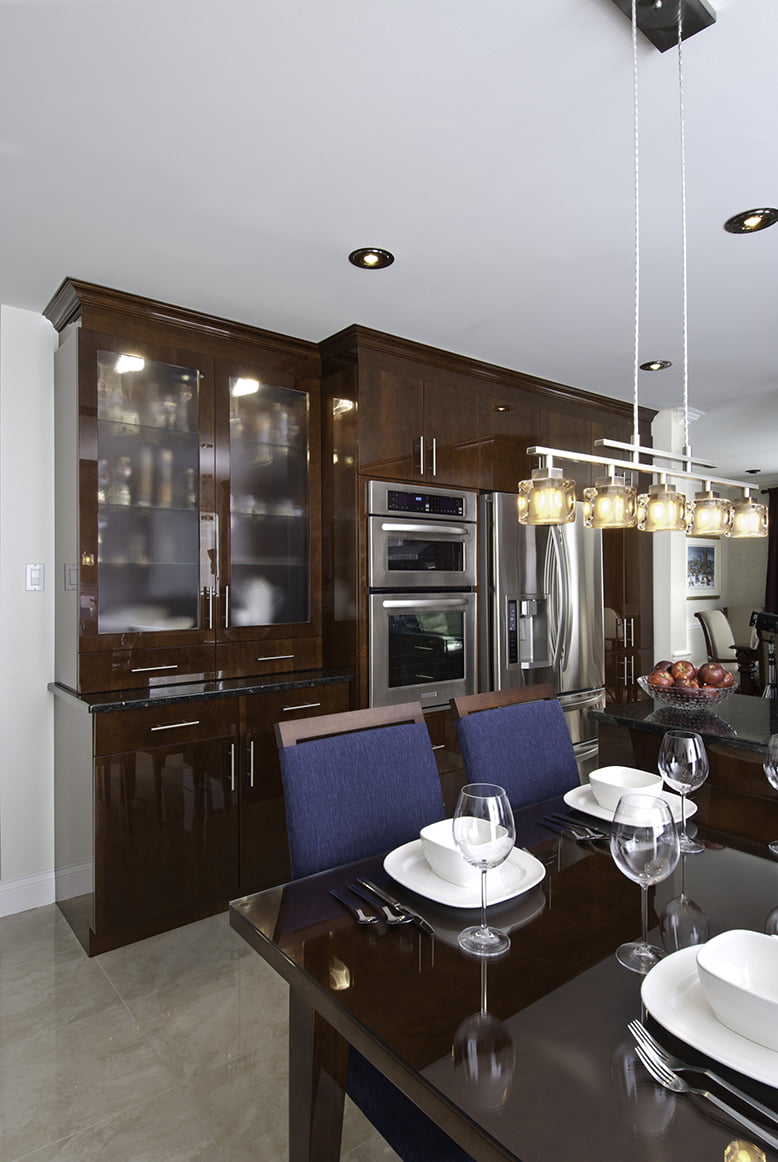What are you looking for when it comes to cabinet construction itself? Not all cabinets are created equal. How do you know if a cabinet is good quality? Here are 5 elements that should be on your radar when shopping for quality cabinetry for your kitchen or bath.

1. How are the cabinets constructed?
This is usually the boring part of the research process. But it’s actually just as important to know about construction, joints, and bracing of cabinets as it is what kind of materials the box is made from. Glue is often used as part of constructing cabinet boxes, so don’t be alarmed if you see a touch of dried glue on the inside corners. However, the process is more than just gluing two pieces of wood together. When a deep groove meets a matching joint—this joint is strong and the glue has more surface to adhere to for extra strength. (This is what we call a “dado joint.”) The “bracing” of the cabinet box is also extremely important for strength and durability. Wood or engineered I-Beams let into the sides, front, and back are preferred for base cabinet construction. Thick cabinet backs let-into the cabinet sides is preferred for wall cabinets. Whether framed or frameless construction, joints, bracing and material thickness keep a cabinet from falling apart and help keep it square.
2. What is the difference between traditional wood cabinet boxes and frameless cabinet boxes?
A traditional wood cabinet box has a face frame (usually 1 ½ inches wide) where the door closes onto the cabinet. If you’re considering a traditional, framed cabinet, and have already confirmed solid construction, good joinery, sturdy bracing, and an all-wood frame, then you’d be making a classic choice. However, if you’re impressed with more accessibility and more useable space inside the cabinet, then frameless (also called “European-style” or “full-access” cabinets) might be the way to go. Frameless describes a process of building a cabinet without the front frame. It doesn’t mean your cabinets will look European because your cabinet door will actually be what determines the style. Cabinet manufacturers offer traditional, transitional or contemporary door styles in both framed and frameless cabinetry. However, the most contemporary kitchens or baths are using frameless cabinetry.
3. What’s the difference between plywood and particleboard?
Throughout the industry, plywood is considered the better choice. Plywood is usually stronger than particleboard and doesn’t expand as easily in moist environments. Is particleboard always bad? Not always. If your cabinet layout includes cabinet boxes next to each other, and they are constructed properly, then the particleboard sides are “buried” and unseen. However, on end cabinets with sides exposed, have your designer specify a “finished end” with a plywood side, or at least an engineered side which has a veneer of real wood. The worst aspect of a particle board cabinet is to have a paper or “picture” of wood on an exposed end rather than real wood. One final thought: if we’re talking about drawers, thin particleboard drawers with staples for joints would not have the lifespan of their wood counterparts. Some cabinet lines may try to cut corners and use particleboard for drawer boxes. Beware!
4. What about the drawers?
In a traditionally framed cabinet, all-wood drawer boxes are the best. The joinery should be dovetailed with the drawer bottom made of a sufficiently dimensioned plywood. The drawer hardware (glides and soft-close hardware) is critical to the sturdiness. Remember, slamming drawers often happens in the bustle of a kitchen. But with the mechanical advancement of slides and soft-close hardware, you can make slamming drawers a thing of the past! For frameless cabinets, soft-close is a must as well, but the drawer boxes can be wood or metal. And always purchase full-extension glides so that you don’t lose useful space!
5. Is the cabinet warranty essential?
While manufacturer warranties are important, what is most important is the stability and longevity of the company with which you are doing business. Warranties are only valuable if the company is still in business when you need them. Purchasing any large ticket products should be from a local business that has been around a long time and has a good service reputation.
Conclusion
Because not all cabinets are created equal, you have to do your research on how they are made in order to really assess their quality. To answer your question, how do I know if a cabinet is good quality… Look for dado joints, all-wood frame and drawers, dovetailed drawers, soft-close drawer hardware, and a lifetime warranty. Don’t be fooled, just because a door style is contemporary and the drawer mechanics are soft-close doesn’t mean the cabinetry is of a good quality. Follow the guidelines in the five questions above, and you will be on your way to finding quality cabinetry.
